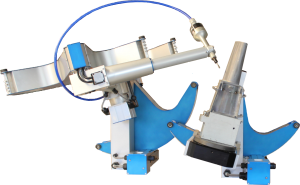Frequently Asked Questions:
- What makes the Touch Robot different than conventional robots?
The Touch Robot works in the same fundamental approach as people do—using the well controlled application of force to perform work. In contrast, conventional robots repeat positions rigidly and blindly. Contact forces are uncontrolled, so they cannot tolerate variation and must be isolated from people. Force-sensitive robots are responsive to their environment, making them safe to work with and able to detect and adapt to variation. - How can the robot protect the safety of employees?
First, it takes over repetitive, strenuous tasks that can inflict repetitive stress injuries (RSIs), such as carpal tunnel syndrome. Second, inherent design features like limited speed, work envelope, and output force make it safe to work alongside humans. - Why force over position?
Working by force relieves positioning requirements of precision and repeatability. Application of force accomplishes the work, with tool-to-part mating geometry determining the motion path. The resultant motion path tells the robot precisely where the workpiece is located, the shape of its surface, and how the applied work is progressing. This permits closed-loop task performance, which is much more robust than the open-loop operation of conventional robots. - How does it sense force?
The system does not use any force sensing. With an extremely efficient power train driving its joints, end-effector force is controlled by commanding motor torque. Using a sensor to control contact forces is inherently unstable, so systems that use this approach must use low control loop gains and accept sluggish response. - What are the benefits of utilizing a Touch Robot?
Some of the benefits of the Touch Robot include more consistent and predictable manufacturing, greater productivity, reduced medical liability, and simplified integration of robotic technology into manual processes. - What size range of parts can the Touch Robot currently handle?
The standard positioner unit accommodates a vertically mounted part 8 x 8 x 16″ high and 25 lbs in weight. Larger parts can be handled with modifications. - How many axes/ degrees of freedom does the Touch Robot have?
6 axes total, with 4 degrees-of-freedom in the robot arm and 2 in the part positioner. While technically 5 degrees-of-freedom would suffice, the extra degree of freedom provides more dexterity and flexibility in machining poses. - What material removal tools does it use?
The Touch Robot was designed to replicate the work of a person, so it is equipped with the same tools a person would use. Primary tools include pneumatically driven die grinders equipped with burrs or abrasive stones, and portable belt grinders. - How long does it take to set up a Touch Robot?
Changing part fixtures, loading the new part program, and changing the material removal tool (if required) can take less than 2 minutes. - What operating system does the software run on/ How is the Touch Robot controlled?
The robot controls run on standard PC hardware, employ open standard control and communication protocols, and use an open-source operating system and libraries. This allows the control platform to stay current with the latest computing technology and protects against obsolescence. The open-source code is not modified and is available for commercial use, so there are no licensing encumbrances. - Can the Touch Robot load and unload parts?
Yes. With the optional tool changer, one of the tool positions can be used for an end-effector. The number of parts that can be processed automatically is limited by the number that can be staged within the robot’s reach (typically 6-8 for small parts). - When/Where can I see the Touch Robot?
You can see the Touch Robots at any of our events, or you can contact us to discuss a meeting.
Feel free to Contact Us if you have any more unanswered questions!

